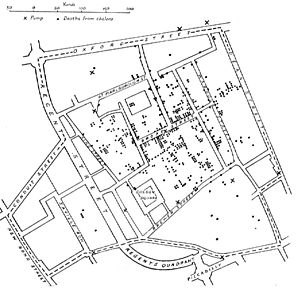Epidemiology facts for kids
Epidemiology is the study of how diseases affect the health of groups of people. It helps us understand how illnesses spread and what makes people sick. This field is very important for public health because it helps prevent diseases and find the best ways to treat them.
Epidemiologists are like health detectives. They start by investigating outbreaks of sickness. Then, they design studies, collect information, and analyze data. They use special math tools called statistics to test their ideas and share what they find. Epidemiologists also look at how different diseases interact within a community. They use knowledge from biology to understand how diseases work, statistics to design good studies, computers to store data and map disease patterns, and social science to understand the bigger reasons behind health issues.
The word "epidemiology" comes from Greek words: epi (meaning "upon" or "among"), demos (meaning "people" or "district"), and logos (meaning "study" or "word"). So, it literally means "the study of what is upon the people." While it mainly focuses on human populations, similar studies are done for animals (called 'epizoology') and plants.
Contents
History of Epidemiology

Long ago, a Greek doctor named Hippocrates was one of the first to think about how diseases and the environment are connected. He explained the difference between 'epidemic' diseases, which suddenly appear and spread among many people, and 'endemic' diseases, which are always present in a certain area.
In the 1020s, a Persian doctor named Avicenna discovered that tuberculosis could spread from person to person. He also noticed that diseases could spread through water and soil. Avicenna believed that tiny, unseen particles could infect people. He even came up with the idea of quarantine to stop contagious diseases from spreading.
During the 14th century, the Black Death (a terrible disease called bubonic plague) reached Spain. Doctors like Ibn Khatima and Ibn al-Khatib thought that infectious diseases were caused by "minute bodies" that entered the human body. They said diseases could spread through touching sick people, or even through their clothes and belongings. Later, an Italian doctor named Girolamo Fracastoro suggested that these tiny, invisible particles that cause disease were alive. He thought they could spread through the air, multiply, and could be destroyed by fire. He disagreed with the old idea that diseases were caused by "bad air." In 1543, Fracastoro wrote a book suggesting that good personal and environmental hygiene could prevent sickness. Much later, in 1675, Antonie van Leeuwenhoek invented a powerful microscope. This allowed people to actually see tiny living particles, which supported the idea that germs cause disease.
In 1662, John Graunt looked at records of deaths in London before the Great Plague of London. His work provided early statistical evidence about diseases. Later, in the 1800s, Dr. John Snow investigated the causes of Cholera outbreaks in London. He noticed that many people getting sick lived in areas supplied by a specific water company. He famously showed that a water pump on Broadwick Street was causing the Soho epidemic. This is a classic example of epidemiology in action. He used chlorine to try and clean the water and had the pump handle removed, which stopped the outbreak. This event was a huge step for public health and is considered the start of modern epidemiology.
The word 'epidemiology' was first used in 1802 by a Spanish doctor named Villalba. Today, the term is used to describe and understand not only epidemic diseases but also health conditions like high blood pressure and obesity.
In 1847, a Hungarian doctor named Ignaz Semmelweis greatly reduced infant deaths at a hospital in Vienna by making doctors disinfect their hands. However, handwashing didn't become common until the British surgeon Joseph Lister discovered antiseptics in 1865, after Louis Pasteur's work on germs. In the early 1900s, scientists like Ronald Ross started using mathematical methods in epidemiology. In 1954, a study led by Richard Doll provided strong evidence that tobacco smoking was linked to lung cancer.
The Profession of an Epidemiologist
Many epidemiologists are doctors or have advanced degrees in public health. Some work in local communities, often for public health services. They are often the first to investigate and fight disease outbreaks. Others work for non-profit groups, universities, hospitals, and large government organizations like the Centers for Disease Control and Prevention (CDC) in the U.S. or the World Health Organization (WHO) globally.
How Epidemiologists Work
Epidemiological studies try to find clear connections between different "exposures" and health outcomes. For example, they might look at how things like smoking, certain foods, or stress relate to serious health problems or even death. They aim to do this without any bias, meaning they try to be as fair and objective as possible.
Managing Health for Groups of People
Epidemiology plays a big role in managing the health of entire populations.
- It helps understand the health status and needs of a specific group of people.
- It guides how health programs are put into action and how well they work.
- It helps provide care for everyone in that population.
Managing health for a whole population is complex today. Epidemiological work is a key part of it. This job requires looking ahead to guide how a health system deals with current health issues and how it can prepare for future health challenges.
Related pages
See also
 In Spanish: Epidemiología para niños
In Spanish: Epidemiología para niños

